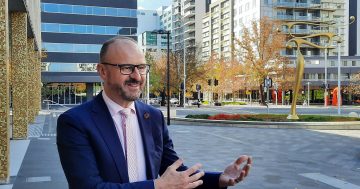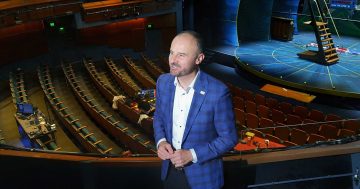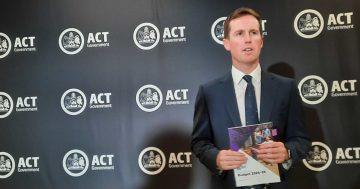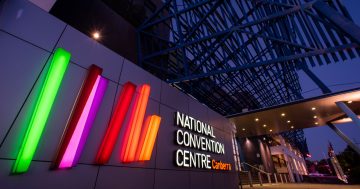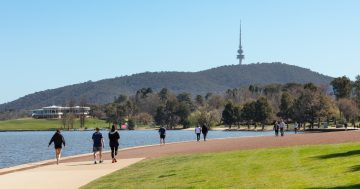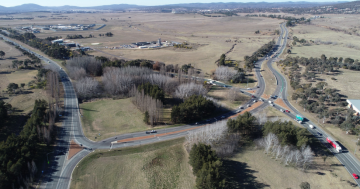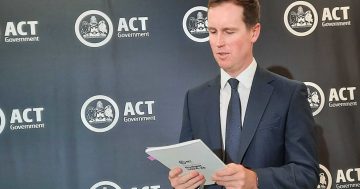
ACT Treasurer Chris Steel said the Federal Budget was a good result for Canberrans. Photo: Ian Bushnell.
The Federal Budget isn’t the end of the story when it comes to Commonwealth funding for the ACT Government’s big-ticket infrastructure projects such as the stadium at Bruce and the new National Convention Centre and entertainment pavilion, according to ACT Treasurer Chris Steel.
The budget failed to allocate any funding for these projects, but Mr Steel said he expected more announcements during the election campaign about to kick off.
Mr Steel said the budget was just one of continuing discussions with the Commonwealth about investment in the ACT and delivering its pipeline of projects as they reach their various stages.
He indicated that any election announcements would likely be more to do with planning and design at this stage.
“The Commonwealth can’t provide construction funding for an infrastructure project until we’ve done that planning and design,” he said.
“That’s a conversation that I’ve been having with [Federal Infrastructure Minister] Catherine King, and the Commonwealth Federal Labor Government is willing to invest in projects as they go through those stages.”
Mr Steel said the Commonwealth had already made commitments to the development of the Australian Institute of Sport and the Bruce precinct where the new stadium would be built.
“The Commonwealth has already invested $10 million in work to look at the feasibility of precinct upgrades around the AIS and the broader Bruce precinct, including the CIT and the Canberra Hospital and the North Canberra Hospital precincts, so that work is already progressing,” he said.
Asked if he was concerned about competition for resources in the lead-up to the 2032 Brisbane Olympics, which will now have a new 60,000-seat stadium, Mr Steel said the Commonwealth could not ignore the needs of Canberra and other cities across Australia.
“There will always be calls on the federal government for infrastructure funding, and we monitor together with them the pipeline of infrastructure around the country, and that’s important to make sure that we get a good price through a procurement for infrastructure projects,” he said.
“The needs aren’t going to go away for cities around the country in terms of building infrastructure and with a rapidly growing city. I think the Commonwealth understands there is a need for continued investment in the capital, and we expect there to be further announcements during the election campaign to support infrastructure in the territory.”
Mr Steel said the Albanese Government was a willing partner in Canberra’s development but warned of a Coalition Government being returned at the coming federal election.
“The biggest risk for this partnership deteriorating and infrastructure projects not being funded is a Dutton-led federal Liberal government that wouldn’t invest in Canberra, and when they were in power for 10 years, [they] didn’t give us our fair share of infrastructure funding.”
Federal Labor had committed $846 for transport projects in the ACT, he said.
He said the budget’s $50 million for the Monaro Highway upgrades was a significant contribution to the city’s southern approaches.
“The Monaro Highway project’s a pretty big ticket item, $290 million now supported by the Commonwealth for that priority, which will improve freight capacity, improve safety on a critical road, supporting the southern part of our city, but also the broader region as well,” he said.
“This is very welcome to have this investment in stage 1 to complete the Lanyon Drive flyover, but also to undertake the work required to support stage 2, which includes the development of the business case for that project as well.”
He also welcomed a further $30 million in the roads to recovery program, including $8.6 million for resurfacing the Kings Highway near Kowen and $3.5 million to complete the duplication of Gundaroo Drive.
Mr Steel said Canberrans would appreciate the budget’s cost of living measures, including the energy rebate, more Medicare incentives for bulk billing, tax cuts and the $10,000 payment to completing construction apprentices.
He said about 100,000 Canberrans would also benefit from the $3 billion investment in the National Broadband Network, upgrading fibre to the node connections.
First-time home buyers would also find it easier to get into their own property with the increased income and property price caps under the Help to Buy scheme.
This would mean with lower deposits and smaller mortgages. The purchase of homes of up to $1 million in Canberra will now be supported under the scheme, up from $750,000.












